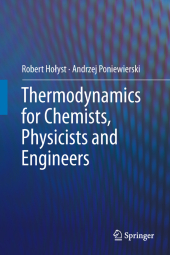 Neuerscheinungen 2014Stand: 2020-02-01 |
Schnellsuche
ISBN/Stichwort/Autor
|
Herderstraße 10
10625 Berlin
Tel.: 030 315 714 16
Fax 030 315 714 14
info@buchspektrum.de |

Robert Holyst, Andrzej Poniewierski
(Beteiligte)
Thermodynamics for Chemists, Physicists and Engineers
2012. 2014. xvi, 344 S. 1 Tabellen. 235 mm
Verlag/Jahr: SPRINGER NETHERLANDS; SPRINGER 2014
ISBN: 9401783047 (9401783047)
Neue ISBN: 978-9401783040 (9789401783040)
Preis und Lieferzeit: Bitte klicken
Written by two recognized experts in soft matter research, this volume presents an elementary introduction to the thermodynamics taught in undergraduate courses. It explains basic concepts and details the applications of the laws to a number of systems.
This textbook takes an interdisciplinary approach to the subject of thermodynamics and is therefore suitable for undergraduates in chemistry, physics and engineering courses. The book is an introduction to phenomenological thermodynamics and its applications to phase transitions and chemical reactions, with some references to statistical mechanics. It strikes the balance between the rigorousness of the Callen text and phenomenological approach of the Atkins text.
The book is divided in three parts. The first introduces the postulates and laws of thermodynamics and complements these initial explanations with practical examples. The second part is devoted to applications of thermodynamics to phase transitions in pure substances and mixtures. The third part covers thermodynamic systems in which chemical reactions take place. There are some sections on more advanced topics such as thermodynamic potentials, natural variables, non-ideal mixtures and electrochemical reactions, which make this book of suitable also to post-graduate students.
From the reviews:
"This book by Holyst and Poniewierski (both, Polish Academy of Sciences) is an introduction to ´phenomenological´ thermodynamics, and a recent addition to a long list of books on this subject. ... One of the most appealing aspects of the book is the end-of-chapter exercises along with the detailed solutions in the appendix. ... The material is appropriate for second-year students in the sciences and engineering ... . Summing Up: Recommended. Lower-division undergraduates." (R. Darby, Choice, Vol. 50 (5), January, 2013)
"The book is divided into 11 chapters, each of them ending with a long series of exercises, whose detailed solutions are gathered at the end of the book in more than 100 pages. ... the book contains several pictures which illustrate the different notions which are introduced. Thus doing, the material which is contained is accessible to different kinds of readers. Chemists will find the useful bases concerning thermodynamical systems. Mathematicians will get acquainted with applications to chemical processes." (Alain Brillard, Zentralblatt MATH, Vol. 1260, 2013)


